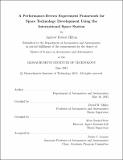| dc.contributor.advisor | David W. Miller and Alvar Saenz-Otero. | en_US |
| dc.contributor.author | Hilton, Andrew Robert | en_US |
| dc.contributor.other | Massachusetts Institute of Technology. Department of Aeronautics and Astronautics. | en_US |
| dc.date.accessioned | 2015-09-17T17:42:32Z | |
| dc.date.available | 2015-09-17T17:42:32Z | |
| dc.date.copyright | 2015 | en_US |
| dc.date.issued | 2015 | en_US |
| dc.identifier.uri | http://hdl.handle.net/1721.1/98559 | |
| dc.description | Thesis: S.M., Massachusetts Institute of Technology, Department of Aeronautics and Astronautics, 2015. | en_US |
| dc.description | This electronic version was submitted by the student author. The certified thesis is available in the Institute Archives and Special Collections. | en_US |
| dc.description | Cataloged from student-submitted PDF version of thesis. | en_US |
| dc.description | Includes bibliographical references (pages 117-120). | en_US |
| dc.description.abstract | Space systems are inherently difficult to verify prior to launch due to the challenges of replicating the space environment through ground testing. The SPHERES testbed on the International Space Station has provided a risk-tolerant test facility for evaluating enabling technology. The operational execution of the SPHERES facility has resulted in the development of best practices for working with experiments in the operational space environment that can be continually refined through successive generations of SPHERES projects. This thesis presents an experiment framework for developing space technology using the International Space Station that focuses on incrementally building toward technology demonstration through the achievement of specific results at each step that are designed to enable an effective demonstration. The operational nature of the ISS constrains both the time available for testing and the control that the scientist can exercise over the experiment. Therefore, this framework addresses the need to design experiment campaigns that can eciently achieve the desired results using data gathered from tests that exhibit unexpected behavior in addition to the tests that exhibit expected behavior. The framework is inspired by the lessons learned from the RINGS project, an attachment to the SPHERES facility that tests Electromagnetic Formation Flight using electromagnetic coils attached to the vehicle. The RINGS experiment campaign is reviewed with a focus on the lessons learned from the operational phase of the project. From these lessons, the experiment framework is developed and presented so that researchers can have a guide in the planning and designing of their experiments for use on remote, operational facilities. The framework is then applied to the next-generation SPHERES project, the Universal Docking Port, as well as the RINGS project, in order provide examples of how this framework can be implemented. | en_US |
| dc.description.statementofresponsibility | by Andrew Robert Hilton. | en_US |
| dc.format.extent | 120 pages | en_US |
| dc.language.iso | eng | en_US |
| dc.publisher | Massachusetts Institute of Technology | en_US |
| dc.rights | M.I.T. theses are protected by copyright. They may be viewed from this source for any purpose, but reproduction or distribution in any format is prohibited without written permission. See provided URL for inquiries about permission. | en_US |
| dc.rights.uri | http://dspace.mit.edu/handle/1721.1/7582 | en_US |
| dc.subject | Aeronautics and Astronautics. | en_US |
| dc.title | A performance-driven experiment framework for space technology development using the International Space Station | en_US |
| dc.type | Thesis | en_US |
| dc.description.degree | S.M. | en_US |
| dc.contributor.department | Massachusetts Institute of Technology. Department of Aeronautics and Astronautics | |
| dc.identifier.oclc | 920686010 | en_US |
